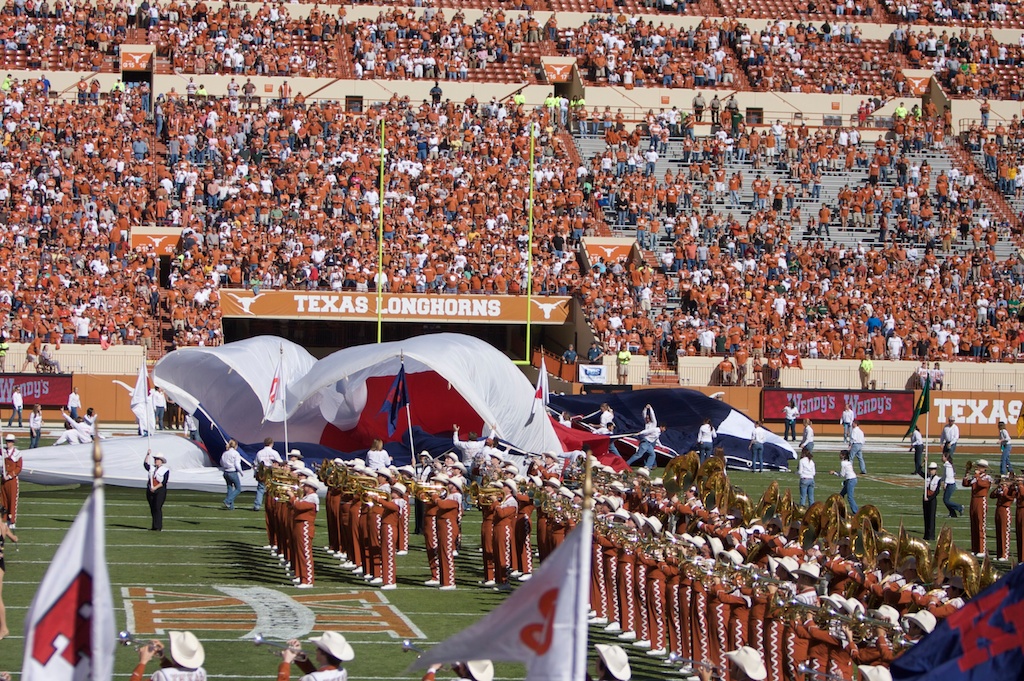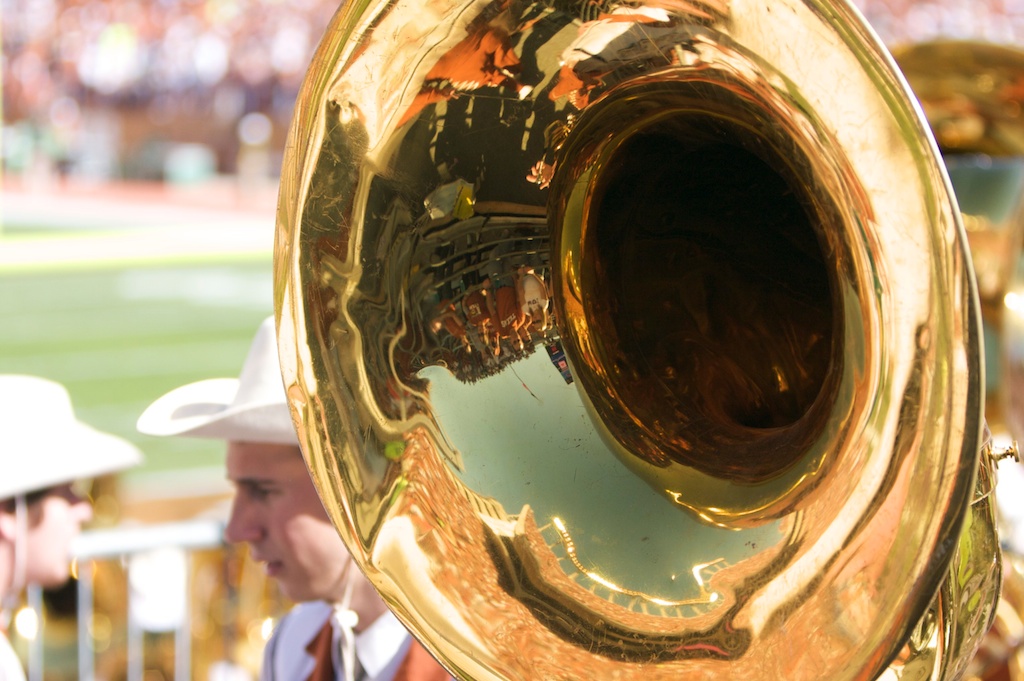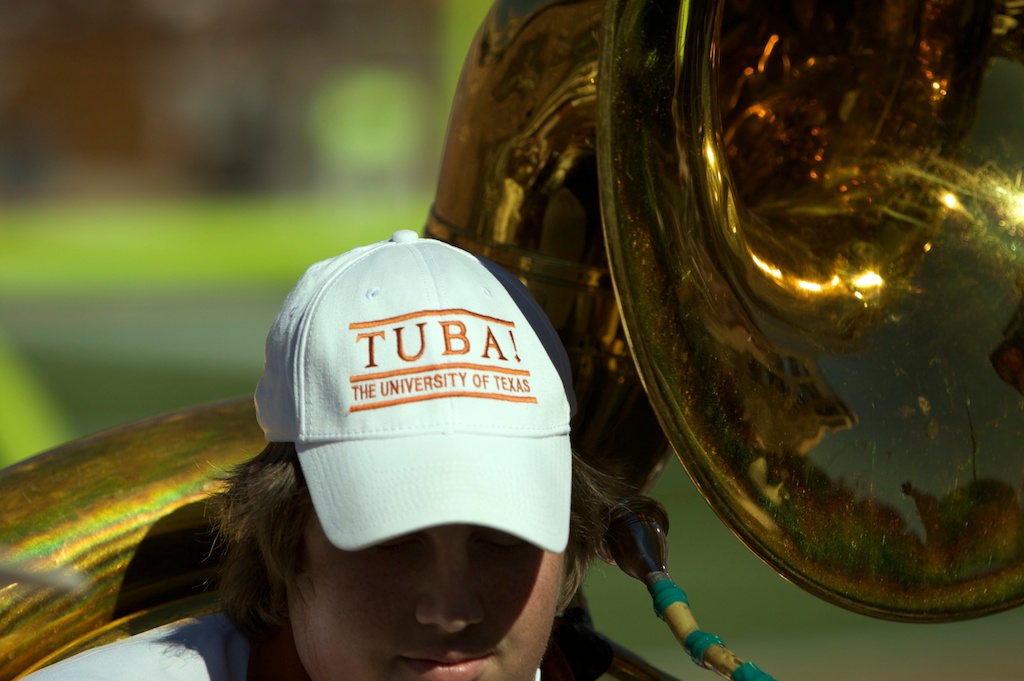November 11, 2008
Asphalt Cocktail: Drunken Relief
I finished the final draft score of “Asphalt Cocktail” today. Now I just need to generate the parts, which is usually a pain in the asphalt. (HA! I may be a little loopy…)
If you’re curious to see the score, you can check out the PDF on the newly-added “Asphalt Cocktail” page.
If you’re a horn, euphonium, or trumpet player, let me know how those parts look. There are some trumpet leaps that I haven’t tried before, the euphonium part is awfully high (and I’m worried it’s too high), and there are some nasty horn sounds that I’m hoping are possible (very low, brassy flutter-tongued stuff).
I feel pretty good about the piece, but I’m way too close to really be able to tell anything about it anymore. The percussion section basically plays rock percussion for six minutes. The highlight, if it works the way I hope, is on page 37, where the groove finally settles into a trashy rock 4/4, complete with back-beats accentuated by the slamming of metal-filled steel trash cans into the floor. (A shout-out to Scott Harris at Stephen F. Austin State University for showing me that.) The trash can is small (only about 12″ tall), and it’s picked up and slammed by the lid handles (with the lids taped on like crazy), so it’s a controlled slam that should sound a little like an amplified set of chains.
It’s kind of like the Mahler Hammer, but more white trash.
November 8, 2008
The Men in Jackets
AEJ and I went to the UT – Baylor football game this afternoon here in Austin. Like a few weeks ago in Columbus, I was at the game as a guest of the band. (This is not a rough life.)
The man to thank for the tickets today: Professor Jerry Junkin, Director of Bands at UT Austin. Yes, he always looks this cool.
Junkin does it all.
Conductor…
… father…
… and golf cart chauffeur.
It’s a lot of fun going to these games. Always lots to see — like the pre-game fly-over.
And tubas.
A lot of people don’t appreciate the burden of being a tuba player. These are some serious guys. The burdens of tuba are, indeed, heavy.
Where do I get a “TUBA!” baseball hat?! Somebody? Come on, Christmas is coming!
“Psst… You guys wanna buy some gasoline?”
Here’s the UT mascot. What’s his name? It seems like I should know his name if I’m going to be a real UT fan.
Some of the conductors unintentionally reenact the last scene of Oceans 11.
The Scarlett Letter was nothing. Commit adultery in Waco, and this is your punishment.
I didn’t have sideline access for this game (like I said, my life is really rough), but we had a great vantage point to take pictures of the guys conducting the marching band in the stands. Here’s Damon Talley, posing for his upcoming album cover, “Jazz Cats.”
Rob Carnochan’s album cover is a bit more introspective.
Cormac Cannon monitors band security during the game. Whenever they spot Junkin approaching, it’s always “Bertha is On Foot. I repeat, Bertha is On Foot.”
Scott Hanna doesn’t take any shit from the clarinets. “Where does the music come from? It’d better F-ING come from RIGHT F-ING HERE.”
I feel like this one should be the cover of an instructional video — something only available on VHS. “Do Re Mi Yi Haw: Teaching the Fundamentals of Texas Music.”
Belt buckle not included.
Oh — there was a football game, too. Well, of sorts. It was tied at one point, but when we left, I think it was 45-14.
Victory is sweet. Hanna gloats.
It was a good time. Hook ’em!
View Comments
Comments
The actual, live, could-be-cut-up-for-really-bad-steaks steer is called Bevo. The current one is Bevo XIV. The stories you hear about how he got his name are probably untrue.
The person in the uncomfortable-looking costume is Hook 'Em. Well, no, that's the person when wearing the costume. I'm sure the person has a normal name that he or she uses when not dressed up like an ambulatory side of beef.
Let's play "Jazz Cats."
Being a guest of the BAND sounds like a dream come true. You can actually *hear* them from there, as opposed to anywhere else in the stadium since they moved them into the corner. And you can see them without binoculars. (disappointed band mom).
Next time, make sure you get a photo of the cymbal section, and my lovely daughter Sami.
Or at least some really good action shots of our boys cuz I need some new material for a sports painting.
Yeah, I've noticed that the band seems a lot quieter, too. I think they moved them because the north end would cause weird echoes otherwise, and because on the students' side, it was always nearly impossible to hear the band unless you were right next to them. But without the east stands acting as a big baffle to contain the sound, I think some of it is getting lost.
Not sure what the solution is -- put them on the north end, maybe? (But those seats are $$$$ for the athletic department...)
I thought that one picture ("Teaching the Fundamentals of Texas Music") was Big Tex at first. :)
http://www.baasclub.com/images/thumbnails/bigtex.jpg
Add comment
November 6, 2008
But You Can Call Me AssCock
There’s a good — and to me, timely — story in today’s New York Times. It’s called “Essay in D: The Critic’s Cogitation About Titles” by Allan Kozinn, and it’s about composers’ titles and the baggage that goes with them.
As Kozinn points out, “Through much of classical music’s history, the titles of secular instrumental works were usually just formal descriptions (symphony, quartet, concerto), and when titles were affixed (“Moonlight,” for example) they were usually a publisher’s idea. Publishers understood that titles, and the imagery they evoked, could help move copies; composers were in it for the art.” I’m going to blame my own personal conflict with titles on the fact that I’m self-published, so while I’d like to just be “in it for the art,” I also have a mortgage to pay, and the publisher side tells me that calling everything “Fantasy #7 for Band” is not doing to help.
Sometimes for me, titles come first. “Turbine” is an example where the title (suggested by AEJ) led to the form (also suggested by AEJ), and it helped a lot while writing the piece to not simply be writing something 100% abstract. In the case of the current piece, “Asphalt Cocktail,” the title was “donated” to me by Jonathan Newman, after several years of begging for it, and that fact has added a lot of pressure to deliver on what the title promises. I don’t remember ever having this much trouble with a piece, primarily because the title froze me up.
Other times, the title comes after the piece is finished. Although I think it fits extremely well and the piece really does sound like the title, “Kingfishers Catch Fire” is an example of that. (AEJ picked the title after hearing the piece.) The titles of the middle movements of my Sax Concerto indicate the scoring for that movement, so those titles of course came first. Another after-the-fact title is “Redline Tango,” half of which is stolen from Steve Bryant. (Speaking of titles, if there’s somebody who can use a poetic, evocative title effectively, without making me cringe in the slightest, it’s Steve.)
Good composers definitely misstep on titles now and again. Even John Adams is no exception. “Short Ride in a Fast Machine” : fantastic title. “My Father Knew Charles Ives” : a little pompous. Well lah-dee-dah to you, John Adams. You don’t see me writing a piece called “My Father Knew Grover Washington Jr.” do you?
My most-hated titles are the ones that just don’t fit — especially when somebody else uses that title, meaning I can’t have it. There’s “Espresso,” a piece that premiered in 2004. When I heard the title, I thought “this is going to be a crazy, non-stop, hyper piece.” Instead, it was dark and sludgy and bitter — the elements of espresso that are less-fun. Or “Grind,” I title I rather wish I could have used, but one that was used a few years ago on a piece that didn’t sound nearly grindy enough to me. There’s a band piece called “Sparkle” that gets a lot of play, and it’s a good piece — but it ain’t sparkly. If you’re going to call a piece “Sparkle,” you need to sparkle my pants off and make me do jazz-hands at the end.
Thoughts? Favorite titles? Worst?
View Comments
Comments
Some of my favourites:
A Child's Garden of Dreams (Maslanka). Fits the music well, of course, since he tried to portray the little girl's dreams through the music.
The Leaves are Falling (Benson). The music just fits. Perfectly. At least in my mind.
In evening's stillness... (Schwantner). Despite the fact that the piece is never still, I think it does fit. Call me crazy.
Sword and the Crown (Gregson). Self-explanatory. Very regal sounding.
Some titles that don't fit the piece:
Dawn's Early Light (Bremer). I like the piece, but when I think of dawn's early light, I don't think of the rhythms and tempo she used.
Galactic Empires (Gillingham). Um. Yeah.
Praise Jerusalem! (Reed). I used to really like this piece when I was in high school. But over the years, I keep asking myself just what exactly sounds "jerusalemy" about it.
Samurai (Clarke). It's like Awayday Part II, and doesn't remind me of Samurai, it reminds me of traffic or industry, for some odd reason.
Dude, I'm not going to Midwest this year...I'm bummed. But I'll see you at CBDNA.
Nice question!
Some other great Adams titles:
--On the Transmigration of Souls
--the "Hail Bop" movement from Century Rolls
--Naive and Sentimental Music
--Slonimsky's Earbox
Other faves:
Frankenstein!! (HK Gruber)
Asyla (Ades)
100 Greatest Dance Hits (Kernis)
The Viola in my Life (Feldman)
Three Screaming Popes (Turnage)
Jesus Blood Never Failed Me Yet (Bryars)
Less favorites:
almost any title by Wuorinen (either too banal or too clever)
Why Patterns? (Feldman)
A Toltec Symphony (Glass) (oh, the multiculti pretension!)
almost any title by Arvo Part (they are entirely interchangeable)
Thanks for the shout-out!
In regard to the original essay, I've never considered calling a piece "Symphony No. 1" - that, to me, is far more presumptuous than an evocative, poetic title. Which was why it was a big deal for me to call something "Concerto for Wind Ensemble."
And I think you *should* write "My Father Knew Grover Washington, Jr." That would be smooth.
I would go on, but that picture has fouled my brain.
Symphony in Bb was an awful title.
there was maybe 5 measures in the key of Bb.
Beethoven's Symphony No. 9, "Coral," really never worked for me. It's just a lot of German singing and nothing at all that evokes diatomacious undersea format...
hmm?
with an H? really? where?
...
...
OHHHHHHHHHHHHHHH. Uh, never mind.
Good blog.
Besides coming up with endings, there is nothing, absolutely nothing I find more soul-crushing than coming up with titles. I would pay good money if someone else would come up with titles for me. Every time I've thought I've come up with a good one, within no time I'm quite convinced it's totally stinko.
View Comments
Comments
Nikk says
John,
The Euphonium A-flats and A-naturals are going to be somewhat tough but certainly not impossible. If anything, they will sometimes be pinched and suffer some intonation troubles, but honestly...any decent college euph player should be able to handle them without a problem.
P.S. The meter signatures look good. Glad it worked out! ;-)
Montoya says
I go to B flats in my piece for Euph.
Jonathan says
Mr. Mackey,
How were you able to make the time signatures look the way they did?
I use Finale 2009, and I it's pretty close to Finale 2008.
P.S. It looks like a fun piece!
Benford says
Trumpet parts look okay. You like high A's, huh? LOL That high D could be tricky but if we're talking primarily college to play it, shouldn't be a problem if there are plenty of trumpet majors in the ensemble.
Congrats on another piece finished!
~C
David says
The horn part isn't bad at all. Assuming some one can flutter tongue, they should be able to flutter tongue in the low register. And that not that low anyways. So it should be fine.
Joey says
I think i got it. Since it sounds "rocky" you chose Asphalt, and (this is just a guess) you choose Cocktail because of the part of the percussion.
I am a trumpet player at Southwest HS in Fort Worth (director Mr. Dunn you may know him) and I am the biggest fan of your music. I love every piece. You are a genius with music. Thank you for contributing your work.
The trumpet parts look good. Can guess there will be some cheating on those slurs ("legato tounging") but I'm sure U.T. won't. They're pretty good.
The horn part looks fun. This year at Southwest we are playing Kingfisher's (CANT WAIT!) and I am doubling on French Horn and helping with the C. Anyway, I'd say that Asphalt Cocktail beats that piece out of the water. It looks extremely tough, but possible, and I'm sure you'll get the effect you want.
Don't know too much about Euphonium, but I have "The Debutante" solo for trumpet and Euphonium and the Euphonium part goes just as high.
I want to be a composer when I get older and you are definitely my hero. What music program do you use for writing? Mine is not so good.
John says
Wow -- comments! Thanks for the feedback about the individual parts. MSU commissioned the piece, and they wanted a flashy opener, so I'm sure they're expecting something technically challenging. I just wanted to be sure I hadn't written things that were completely impossible.
As for the cool, big time signatures, those are courtesy of Nikk Pilato (see comment from Nikk above). Here, step by step, is exactly what Nikk told me. I did it just like he suggested, only I used a different font:
I think it looks really good, and compared with lots of tiny meter changes, this is a lot easier to read. It also makes the piece look legit.
And to answer Joey's question, I still use Finale 2008. I kind of hate it -- holy buggy -- but I manage.
Travis Taylor says
I knew you hated Finale! I knew it!
-Travis-
Count Fosco says
(I don't read music too well, so I'll just trust the other commenters that this piece is brilliant.)
Re: Mahler hammer. I always thought Mahler was pretty white trash, what with all the military-band love. And he and his wife would have been great on Springer, no?
Benford says
Music looking legit? But I thought you were going for trashy....
;)
~C
Ray says
The piece looks awesome. The time signatures look legit too. Sweet job. Looking forward to hearing it.
As for the low horn flutter tongue stuff, that stuff's not bad at all. In fact, if played loud and brassy as you indicate on the score, it should sound damn cool and dirty. I'm liking all the rips, too...ha.
Kasey says
Hi John,
I'm Kasey Warren 1st chair trumpet in my wind ensemble and lead trumpet in my jazz band. I have been inspired by your pieces (especially Redline Tango).
About the piece - I would say that this is a high 4/ low 5 in difficulty./? I see many of the people who have already posted pretty much covered my opinions. Most good high school wind ensembles could pull this off. The trumpet jumps are not as crazy as Gordon Goodwin's 4th trumpet jumps in Sing Sang Sung, so those should be fine. The euphonium part is a little high, yet capable of playing. In fact I have some friends that can play that high. May I suggest that those high notes be an option 8va?
Brandon says
I'm a Euphonium player and just want to say that while you're a little bit evil for keeping the Euphoniums in the top of the tessitura for almost the entire piece hehe (High Ab's galore), it's perfectly doable for the Euphonium players of the ensembles that are in the echelon of skill that will be typically attempting this piece (Universities, and really good--a.k.a "Texas"--HS Bands)
For comparison, the Weber transcription of Hindemith's "Symphonic Metamorphosis" gives the Euphoniums the Bb3~Bb4 octave jumps at the end of the March along with the Horns. And that piece is on the UIL PML for Texas HS bands. The highest note you wrote for the Euphonium in "Asphalt Cocktail" is an optional C5 which is fine, but I wouldn't write anything higher than that, even with *optionals*. Once you get higher than C5 you're in the screamer range of the instrument and there's a huge wall of stuffiness that performers have to work against to play higher than that. I've seen works before that had a C5 written but I've never had to play anything higher than that in an ensemble (though solo literature is another story).
Robert Benton says
John,
We read this piece on Friday (you should have the recording soon) and it will be great. As you'll hear on the recording, balancing it so that you hear everything that's going on would be the number one issue (at least that's the way it was from my seat). Of course keeping the tempo up will be a challenge as well, but nothing we can't do.
Being a euphonium player, here's my take on the part: it's fine. The high C is well placed, supported and it's not too difficult to jump there from the G. In my professional opinion, the euphonium is at it's best between middle C and high C*. Before practicing the piece, just looking the part over raised an eyebrow, (many repeated measures in the F-G-Ab range) but in practice, there is plenty of rest to make up for any endurance issues.
* - much of this depends on the level of playing. If you were writing for a top university band or one of the DC bands you can go up to Eb (mostly for effects or punctuation). Most other college players will not have difficulty with the C in this piece. Writing for high school, I would stay below Bb
I'm looking forward to working on this piece with you and performing it in March.
Best Regards,
Robert Benton
Euphonium
Michigan State University
Ian Gelarden says
the clarinet solo is WICKED AWESOME! sorry for the slightly informal comment but im playing that solo on this piece and its great. I rarely get to do bends and smears in concert band.
Zack says
Mr. Mackey,
I'm a freshman music ed. major at MSU. I attended the unofficial premiere of Asphalt Cocktail in February. I love the piece. And I have to say I like your changes a lot in this version (the posted from CBDNA). The added build-up before it finally settles into the rock groove at the end gave it a little more closure for me.
Awesome music. Can't wait to hear more.
-ZW
Peter says
Played at our High School for state competition in which the Band won the State Competition. Asphalt Cocktail was included in the selections. This song is amazing and I fell in love with it. Awesome job.
Add comment